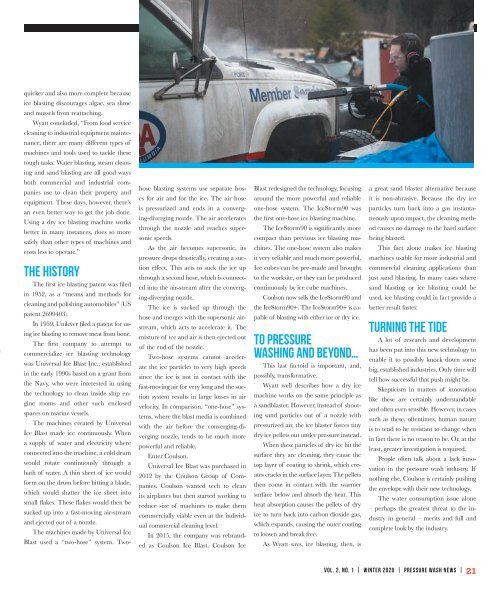You also want an ePaper? Increase the reach of your titles
YUMPU automatically turns print PDFs into web optimized ePapers that Google loves.
quicker and also more complete because<br />
ice blasting discourages algae, sea slime<br />
and mussels from reattaching.<br />
Wyatt concluded, “From food service<br />
cleaning to industrial equipment maintenance,<br />
there are many different types of<br />
machines and tools used to tackle these<br />
tough tasks. Water blasting, steam cleaning<br />
and sand blasting are all good ways<br />
both commercial and industrial companies<br />
use to clean their property and<br />
equipment. These days, however, there’s<br />
an even better way to get the job done.<br />
Using a dry ice blasting machine works<br />
better in many instances, does so more<br />
safely than other types of machines and<br />
costs less to operate.”<br />
THE HISTORY<br />
The first ice blasting patent was filed<br />
in 1952, as a “means and methods for<br />
cleaning and polishing automobiles” (US<br />
patent 2699403).<br />
In 1959, Unilever filed a patent for using<br />
ice blasting to remove meat from bone.<br />
The first company to attempt to<br />
commercialize ice blasting technology<br />
was Universal Ice Blast Inc., established<br />
in the early 1990s based on a grant from<br />
the Navy, who were interested in using<br />
the technology to clean inside ship engine<br />
rooms and other such enclosed<br />
spaces on marine vessels.<br />
The machines created by Universal<br />
Ice Blast made ice continuously. When<br />
a supply of water and electricity where<br />
connected into the machine, a cold drum<br />
would rotate continuously through a<br />
bath of water. A thin sheet of ice would<br />
form on the drum before hitting a blade,<br />
which would shatter the ice sheet into<br />
small flakes. These flakes would then be<br />
sucked up into a fast-moving air-stream<br />
and ejected out of a nozzle.<br />
The machines made by Universal Ice<br />
Blast used a “two-hose” system. Twohose<br />
blasting systems use separate hoses<br />
for air and for the ice. The air hose<br />
is pressurized and ends in a converging-diverging<br />
nozzle. The air accelerates<br />
through the nozzle and reaches supersonic<br />
speeds.<br />
As the air becomes supersonic, its<br />
pressure drops drastically, creating a suction<br />
effect. This acts to suck the ice up<br />
through a second hose, which is connected<br />
into the air-stream after the converging-diverging<br />
nozzle.<br />
The ice is sucked up through the<br />
hose and merges with the supersonic airstream,<br />
which acts to accelerate it. The<br />
mixture of ice and air is then ejected out<br />
of the end of the nozzle.<br />
Two-hose systems cannot accelerate<br />
the ice particles to very high speeds<br />
since the ice is not in contact with the<br />
fast-moving air for very long and the suction<br />
system results in large losses in air<br />
velocity. In comparison, “one-hose” systems,<br />
where the blast media is combined<br />
with the air before the converging-diverging<br />
nozzle, tends to be much more<br />
powerful and reliable.<br />
Enter Coulson.<br />
Universal Ice Blast was purchased in<br />
2012 by the Coulson Group of Companies.<br />
Coulson wanted tech to clean<br />
its airplanes but then started working to<br />
reduce size of machines to make them<br />
commercially viable even at the individual<br />
commercial cleaning level.<br />
In 2015, the company was rebranded<br />
as Coulson Ice Blast. Coulson Ice<br />
Blast redesigned the technology, focusing<br />
around the more powerful and reliable<br />
one-hose system. The IceStorm90 was<br />
the first one-hose ice blasting machine.<br />
The IceStorm90 is significantly more<br />
compact than previous ice blasting machines.<br />
The one-hose system also makes<br />
it very reliable and much more powerful.<br />
Ice cubes can be pre-made and brought<br />
to the worksite, or they can be produced<br />
continuously by ice cube machines.<br />
Coulson now sells the IceStorm90 and<br />
the IceStorm90+. The IceStorm90+ is capable<br />
of blasting with either ice or dry ice.<br />
TO PRESSURE<br />
WASHING AND BEYOND…<br />
This last factoid is important, and,<br />
possibly, transformative.<br />
Wyatt well describes how a dry ice<br />
machine works on the same principle as<br />
a sandblaster. However, instead of shooting<br />
sand particles out of a nozzle with<br />
pressurized air, the ice blaster forces tiny<br />
dry ice pellets out under pressure instead.<br />
When these particles of dry ice hit the<br />
surface they are cleaning, they cause the<br />
top layer of coating to shrink, which creates<br />
cracks in the surface layer. The pellets<br />
then come in contact with the warmer<br />
surface below and absorb the heat. This<br />
heat absorption causes the pellets of dry<br />
ice to turn back into carbon dioxide gas,<br />
which expands, causing the outer coating<br />
to loosen and break free.<br />
As Wyatt says, ice blasting, then, is<br />
a great sand blaster alternative because<br />
it is non-abrasive. Because the dry ice<br />
particles turn back into a gas instantaneously<br />
upon impact, the cleaning method<br />
causes no damage to the hard surface<br />
being blasted.<br />
This fact alone makes ice blasting<br />
machines usable for more industrial and<br />
commercial cleaning applications than<br />
just sand blasting. In many cases where<br />
sand blasting or ice blasting could be<br />
used, ice blasting could in fact provide a<br />
better result faster.<br />
TURNING THE TIDE<br />
A lot of research and development<br />
has been put into this new technology to<br />
enable it to possibly knock down some<br />
big, established industries. Only time will<br />
tell how successful that push might be.<br />
Skepticism in matters of innovation<br />
like these are certainly understandable<br />
and often even sensible. However, in cases<br />
such as these, oftentimes, human nature<br />
is to tend to be resistant to change when<br />
in fact there is no reason to be. Or, at the<br />
least, greater investigation is required.<br />
People often talk about a lack innovation<br />
in the pressure wash industry. If<br />
nothing else, Coulson is certainly pushing<br />
the envelope with their new technology.<br />
The water consumption <strong>issue</strong> alone<br />
– perhaps the greatest threat to the industry<br />
in general – merits and full and<br />
complete look by the industry.<br />
VOL. 2, NO. 1 | WINTER 2020 | PRESSURE WASH NEWS | 21

















